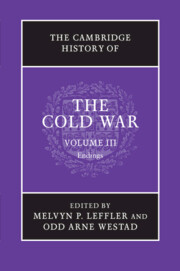Book contents
- Frontmatter
- 1 The Cold War and the intellectual history of the late twentieth century
- 2 The world economy and the Cold War, 1970–1990
- 3 The rise and fall of Eurocommunism
- 4 The Cold War and Jimmy Carter
- 5 Soviet foreign policy from détente to Gorbachev, 1975–1985
- 6 Islamism, the Iranian revolution, and the Soviet invasion of Afghanistan
- 7 The collapse of superpower détente, 1975–1980
- 8 Japan and the Cold War, 1960–1991
- 9 China and the Cold War after Mao
- 10 The Cold War in Central America, 1975–1991
- 11 The Cold War and southern Africa, 1976–1990
- 12 The Gorbachev revolution and the end of the Cold War
- 13 US foreign policy under Reagan and Bush
- 14 Western Europe and the end of the Cold War, 1979–1989
- 15 The East European revolutions of 1989
- 16 The unification of Germany, 1985–1991
- 17 The collapse of the Soviet Union, 1990–1991
- 18 Science, technology, and the Cold War
- 19 Transnational organizations and the Cold War
- 20 The biosphere and the Cold War
- 21 The Cold War and human rights
- 22 The Cold War in the longue durée: global migration, public health, and population control
- 23 Consumer capitalism and the end of the Cold War
- 24 An ‘incredibly swift transition’: reflections on the end of the Cold War
- 25 The restructuring of the international system after the Cold War
- Bibliographical essay
- Index
- References
10 - The Cold War in Central America, 1975–1991
Published online by Cambridge University Press: 28 September 2010
- Frontmatter
- 1 The Cold War and the intellectual history of the late twentieth century
- 2 The world economy and the Cold War, 1970–1990
- 3 The rise and fall of Eurocommunism
- 4 The Cold War and Jimmy Carter
- 5 Soviet foreign policy from détente to Gorbachev, 1975–1985
- 6 Islamism, the Iranian revolution, and the Soviet invasion of Afghanistan
- 7 The collapse of superpower détente, 1975–1980
- 8 Japan and the Cold War, 1960–1991
- 9 China and the Cold War after Mao
- 10 The Cold War in Central America, 1975–1991
- 11 The Cold War and southern Africa, 1976–1990
- 12 The Gorbachev revolution and the end of the Cold War
- 13 US foreign policy under Reagan and Bush
- 14 Western Europe and the end of the Cold War, 1979–1989
- 15 The East European revolutions of 1989
- 16 The unification of Germany, 1985–1991
- 17 The collapse of the Soviet Union, 1990–1991
- 18 Science, technology, and the Cold War
- 19 Transnational organizations and the Cold War
- 20 The biosphere and the Cold War
- 21 The Cold War and human rights
- 22 The Cold War in the longue durée: global migration, public health, and population control
- 23 Consumer capitalism and the end of the Cold War
- 24 An ‘incredibly swift transition’: reflections on the end of the Cold War
- 25 The restructuring of the international system after the Cold War
- Bibliographical essay
- Index
- References
Summary
The strategic stalemate that prevented a direct military conflict between the United States and the Soviet Union displaced violent superpower competition to areas of the Third World where the two blocs could invest in local and regional wars without risking direct confrontation. The Soviet Union tended to approach such conflicts cautiously even when they involved other Communist states. The United States, by contrast, adapted its security policies to a containment doctrine that defined the political complexion of every non-Communist government in the world as a matter of potential strategic interest. Local opposition to foreign rule in the US and European colonial empires, and social movements aiming to displace traditional elites elsewhere, confronted a strong US preference for reliably anti-Communist (and thus conservative to right-wing) regimes. Even moderate to conservative regimes that sought to advance national interests by constraining US influence came under assault from Washington. Governments that collaborated closely with the United States often had to ignore or suppress local interests opposed to US policies.
In its prosecution of the Cold War in the Third World, the United States enjoyed formidable advantages over its Soviet rival. Economic strength gave US leaders a decided financial and material advantage over the Soviets. Military bases projected US power into regions bordering on Communist states throughout the world. US ideological and cultural assets also helped. Alliances with local elites eager to reduce domestic challenges proved especially helpful. The United States deployed all of these resources in response to perceived affronts to its regime and policy preferences wherever they occurred.
- Type
- Chapter
- Information
- The Cambridge History of the Cold War , pp. 201 - 221Publisher: Cambridge University PressPrint publication year: 2010
References
- 15
- Cited by

